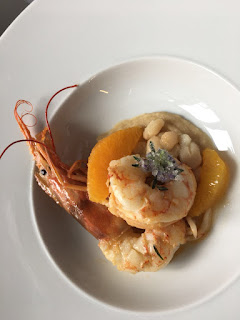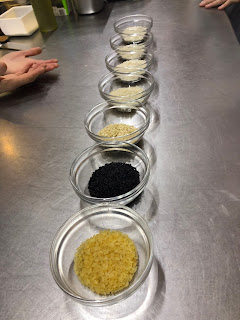Cibo da Favola Al Castello
At the end of the block, we had to prepare a lunch for outside guests to enjoy at the Castello. This was an excellent opportunity to show what we have learned since being in Italy. Some dishes were influenced by dishes we prepared in class, while others were inspired by dishes enjoyed at restaurants in the area.
For this lunch, we had to prepare a four-course meal for 12 guests that we, as a class, invited. My group chose dessert (which I was very excited about), while other groups prepared an appetizer, pasta, and entree course. We also had to come up with a theme and we chose "Cibo da Favola Al Castello," which was basically a meal inspired by folktales. This means that each course had a folktale/fairytale to go along with it. From wine pairings to table decoration, this was a great lunch that as a class, we executed pretty well.
This dessert was a lot of fun to make and plate, even if I was sick at the time (I woke up with a very upset stomach)! The most difficult part was getting my recipes from school to work here because the flour is different in Italy than in the US. This presented to be a challenge for me and made me really think about the recipes I was doing and what I wanted the end product to look like. This was interesting to see the different types of products used here versus in the states - like the use of glucose syrup/corn syrup! This is not found in Europe at all and quite a few of my recipes had it in there, which meant some changes in liquids or sugars. In the end, I really liked the way everything came out and I was in love with the plating of it. Let me know what you think in the comments!
I would also like to use this blog post to wrap up the time that we studied Northern Italian Cuisine because next week, we begin Southern Italy! I am very pleased with the dishes we were able to create and types of traditions we saw throughout each region. Even with regions that are boarding one another, each has a very unique cuisine, unlike any other. This shows me that there is no one Italian cuisine because no matter where you go in Italy, the food is going to be different. I have broken down each region and wanted to give a final note on each:
- Marche: This region uses a lot of fish in their simple, but extremely flavorful dishes. This was by far, my favorite region we learned, cooked, and ate!
- Emilia-Romagna: Within Emilia-Romagna, they use a lot of eggs, butter, parmagina regiano, and granda padano. This is very different from a lot of other regions in Italy, producing a more fatty, hearty cuisine. They also use more meat than fish overall.
The spice that defines this region: nutmeg!
- Tuscany: Tuscany has a very unique, hearty cuisine, using a lot of bread, olive oil, and very little eggs! The most interesting culinary part of this region They do not put salt in their bread.
- Liguria: This cuisine is very healthy, light, and fishy. They are right on the water using a lot of veggies, herbs, capers, and anchovies. They also use yogurt and olive oil, no butter or really even cheese!
- Venice: In Venice, they cook with a lot of red wine and vinegar in both their fish and meat preparations. This cuisine uses a lot of polenta, anchovies, braised vegetables, and chicken liver. They also cook with a lot of milk in both their meat and fish preparations.
The spice that defines this region: Sage
- Trentino Alto Alige: Within this German influence cuisine, there is a lot of meat veggies, and potatoes used. They use a lot of stale bread, butter, milk, and sugar. A lot of their preparations are boiled, from potatoes to meat. They use sugar for energy because they are in the mountains, so their "desserts" are often just their meals. They make pasta with poppy seeds!
The spice that defines this region: Chives (& Cumin)
- Fruili Venezia Giulia: They have a sweet cuisine with the use of poppy seeds, apples, cinnamon, and nuts. They also use a lot of potatoes, spices, onions, and vinegar/wine. This region thickens their soups with polenta, unlike any other.
The spice that defines this region: Paprika
- Piemonte: This is a very rich cuisine with the use of butter, cream, and cheese. They have a lot of different pastas and custards. They also use herbs, vinegar, wine, and lots of hazelnuts.
The spice that defines this region: Sage
- Lombardia: This is also a rich, hearty cuisine with the use of polenta, rice, pasta, cheese, and butter. They use buckwheat flour in their pasta and there is not a lot of bread used because of the amount of polenta that is consumed.
The spice that defines this region: Sage
With Love,
Baylee
For this lunch, we had to prepare a four-course meal for 12 guests that we, as a class, invited. My group chose dessert (which I was very excited about), while other groups prepared an appetizer, pasta, and entree course. We also had to come up with a theme and we chose "Cibo da Favola Al Castello," which was basically a meal inspired by folktales. This means that each course had a folktale/fairytale to go along with it. From wine pairings to table decoration, this was a great lunch that as a class, we executed pretty well.
First Course (Appetizer)
Camberi al rosmarino con fagioli e arancia
Bean puree with shrimp & orange
Second Course (Pasta)
Pappardelle con le erbe del nostro giardino, uovo crudo e limone olio al crisantemo
Laminated pasta dough with herbs, cheese nest, confit egg yolk
Third Course (Entree)
Capretto brasato, polenta con aglio al forno, insalata di bieta e mandorle
Braised rolled goat with polenta and swiss chard
Fourth Course (Dessert)
Spicchio di arancia, cioccolato e finocchio
Tart cresent, fennel ice cream, dehydrated orange, chocolate ganache, chocolate cake, orange marmalade, candied cedar, fried fennel
I would also like to use this blog post to wrap up the time that we studied Northern Italian Cuisine because next week, we begin Southern Italy! I am very pleased with the dishes we were able to create and types of traditions we saw throughout each region. Even with regions that are boarding one another, each has a very unique cuisine, unlike any other. This shows me that there is no one Italian cuisine because no matter where you go in Italy, the food is going to be different. I have broken down each region and wanted to give a final note on each:
- Marche: This region uses a lot of fish in their simple, but extremely flavorful dishes. This was by far, my favorite region we learned, cooked, and ate!
- Emilia-Romagna: Within Emilia-Romagna, they use a lot of eggs, butter, parmagina regiano, and granda padano. This is very different from a lot of other regions in Italy, producing a more fatty, hearty cuisine. They also use more meat than fish overall.
The spice that defines this region: nutmeg!
- Tuscany: Tuscany has a very unique, hearty cuisine, using a lot of bread, olive oil, and very little eggs! The most interesting culinary part of this region They do not put salt in their bread.
- Liguria: This cuisine is very healthy, light, and fishy. They are right on the water using a lot of veggies, herbs, capers, and anchovies. They also use yogurt and olive oil, no butter or really even cheese!
- Venice: In Venice, they cook with a lot of red wine and vinegar in both their fish and meat preparations. This cuisine uses a lot of polenta, anchovies, braised vegetables, and chicken liver. They also cook with a lot of milk in both their meat and fish preparations.
The spice that defines this region: Sage
- Trentino Alto Alige: Within this German influence cuisine, there is a lot of meat veggies, and potatoes used. They use a lot of stale bread, butter, milk, and sugar. A lot of their preparations are boiled, from potatoes to meat. They use sugar for energy because they are in the mountains, so their "desserts" are often just their meals. They make pasta with poppy seeds!
The spice that defines this region: Chives (& Cumin)
- Fruili Venezia Giulia: They have a sweet cuisine with the use of poppy seeds, apples, cinnamon, and nuts. They also use a lot of potatoes, spices, onions, and vinegar/wine. This region thickens their soups with polenta, unlike any other.
The spice that defines this region: Paprika
- Piemonte: This is a very rich cuisine with the use of butter, cream, and cheese. They have a lot of different pastas and custards. They also use herbs, vinegar, wine, and lots of hazelnuts.
The spice that defines this region: Sage
- Lombardia: This is also a rich, hearty cuisine with the use of polenta, rice, pasta, cheese, and butter. They use buckwheat flour in their pasta and there is not a lot of bread used because of the amount of polenta that is consumed.
The spice that defines this region: Sage
With Love,
Baylee









Comments
Post a Comment